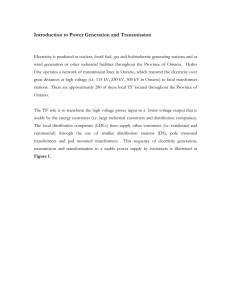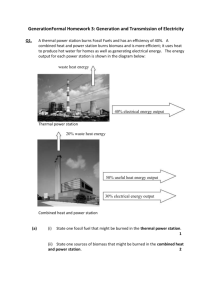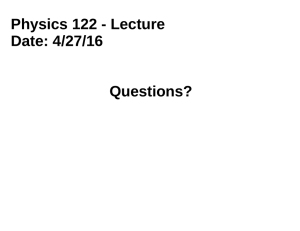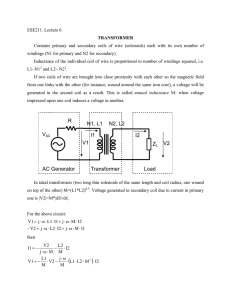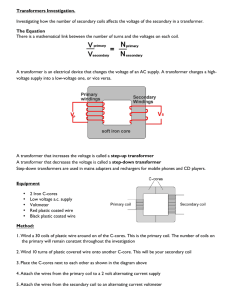20-7 Transformers and the Transmission of Electricity
advertisement
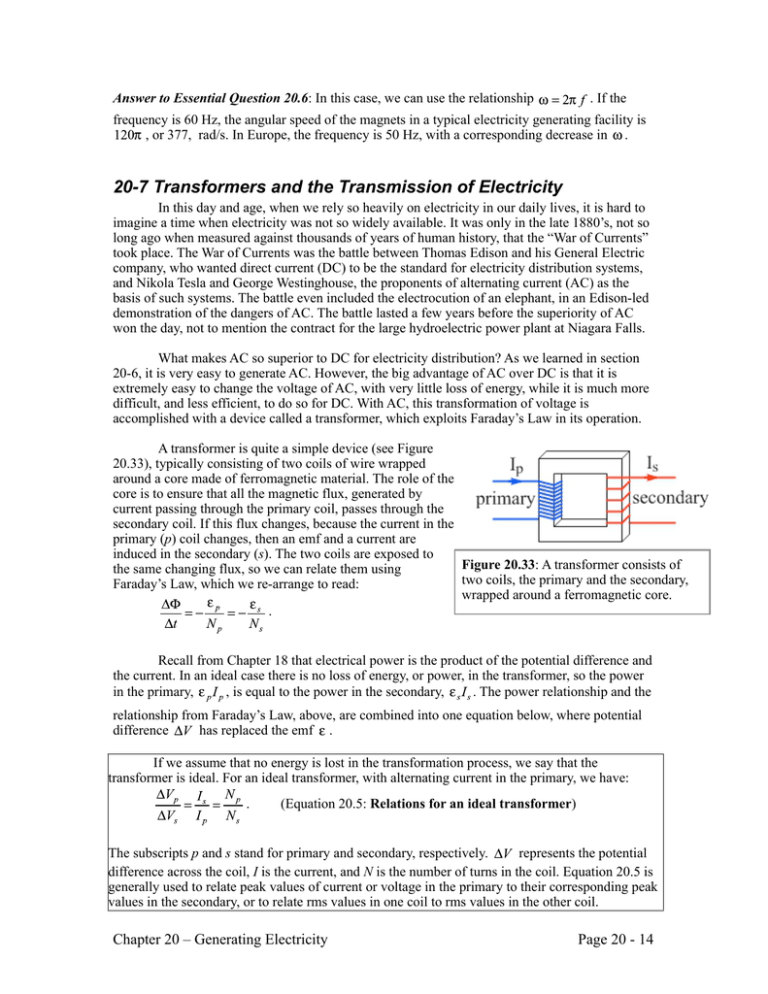
Answer to Essential Question 20.6: In this case, we can use the relationship . If the frequency is 60 Hz, the angular speed of the magnets in a typical electricity generating facility is , or 377, rad/s. In Europe, the frequency is 50 Hz, with a corresponding decrease in . 20-7 Transformers and the Transmission of Electricity In this day and age, when we rely so heavily on electricity in our daily lives, it is hard to imagine a time when electricity was not so widely available. It was only in the late 1880’s, not so long ago when measured against thousands of years of human history, that the “War of Currents” took place. The War of Currents was the battle between Thomas Edison and his General Electric company, who wanted direct current (DC) to be the standard for electricity distribution systems, and Nikola Tesla and George Westinghouse, the proponents of alternating current (AC) as the basis of such systems. The battle even included the electrocution of an elephant, in an Edison-led demonstration of the dangers of AC. The battle lasted a few years before the superiority of AC won the day, not to mention the contract for the large hydroelectric power plant at Niagara Falls. What makes AC so superior to DC for electricity distribution? As we learned in section 20-6, it is very easy to generate AC. However, the big advantage of AC over DC is that it is extremely easy to change the voltage of AC, with very little loss of energy, while it is much more difficult, and less efficient, to do so for DC. With AC, this transformation of voltage is accomplished with a device called a transformer, which exploits Faraday’s Law in its operation. A transformer is quite a simple device (see Figure 20.33), typically consisting of two coils of wire wrapped around a core made of ferromagnetic material. The role of the core is to ensure that all the magnetic flux, generated by current passing through the primary coil, passes through the secondary coil. If this flux changes, because the current in the primary (p) coil changes, then an emf and a current are induced in the secondary (s). The two coils are exposed to Figure 20.33: A transformer consists of the same changing flux, so we can relate them using two coils, the primary and the secondary, Faraday’s Law, which we re-arrange to read: wrapped around a ferromagnetic core. . Recall from Chapter 18 that electrical power is the product of the potential difference and the current. In an ideal case there is no loss of energy, or power, in the transformer, so the power in the primary, , is equal to the power in the secondary, . The power relationship and the relationship from Faraday’s Law, above, are combined into one equation below, where potential difference has replaced the emf . If we assume that no energy is lost in the transformation process, we say that the transformer is ideal. For an ideal transformer, with alternating current in the primary, we have: . (Equation 20.5: Relations for an ideal transformer) The subscripts p and s stand for primary and secondary, respectively. represents the potential difference across the coil, I is the current, and N is the number of turns in the coil. Equation 20.5 is generally used to relate peak values of current or voltage in the primary to their corresponding peak values in the secondary, or to relate rms values in one coil to rms values in the other coil. Chapter 20 – Generating Electricity Page 20 - 14 Note that transformers require a changing magnetic flux to generate a current in the secondary coil. Such a changing magnetic flux is provided by alternating current running through the primary, generating alternating current in the secondary. What is a transformer good for? In general, transformers are used to change the voltage from a wall socket into a different voltage, which could be higher or lower, for use by a particular device. Some devices, such as microwave ovens and cathode ray tube televisions, require higher voltages than the 120 V rms that is provided by a wall socket in North America. Such devices have a step-up transformer, in which the secondary coil has a larger number of turns than the primary, to increase the voltage to the required level. Many devices also require a constant voltage, so the transformers also convert the alternating current to direct current. Other devices, such as computers and clock radios, require a voltage such as 12 V, much less than the 120 V rms from a wall socket, to operate. The power cord in these devices is thus connected to a step-down transformer, in which the secondary coil has a smaller number of turns than the primary, to decrease the voltage. Note that, by energy (or power) conservation, decreasing the voltage is associated with an increase in current. In step-up transformers, on the other hand, the increase in voltage is accompanied by a corresponding decrease in current. EXPLORATION 20.7 – Transformers in the electricity distribution system A particular electricity generating facility generates electricity at the rate of 2.4 MW, with an rms current of 1000 A at an rms voltage of 2.4 kV. Step 1 – If the electricity is sent through a cable (known as a transmission line) that has a resistance of 10 ! on its way to New York City, determine the power lost during the transmission process . Here we can apply one version of the power equation from chapter 18, . This is clearly ridiculous, because this power is more than 4 times larger than the power generated by the plant. The bottom line is that essentially all the electrical energy would be dissipated in the transmission line. Step 2 – If, instead, the voltage is transformed to 240 kV before the electricity is sent along the transmission line, what is the power lost in the transmission process? Applying equation 20.5, increasing the voltage by a factor of 100 produces a corresponding decrease by a factor of 100, to 10 A, in the current. With 10 A of current in the transmission line, the power lost now is only . This is why power companies transmit electricity over long distances at high voltages, to minimize the current, thereby minimizing transmission losses. Step 3 – The voltage is ultimately transformed back down to 120 V in New York City. What is the value of the rms current? Neglecting the power lost in step 2, stepping the voltage down by a factor of 2000, from 240 kV to 120 V, increases the current by this same factor of 2000, from 10 A to 20000 A, enough to meet the needs of a large number of residential customers. Key ideas: Power companies make extensive use of both step-up and step-down transformers in the process of delivering electricity. Related End-of-Chapter Exercises: 36 – 40, 60. Essential Question 20.7: A particular transformer has a primary coil with 100 turns and a secondary coil with 200 turns. If the primary coil has a constant potential difference of 20 V and a constant current of 5 A, what are the values of the potential difference across, and current in, the secondary? Assume the transformer is ideal. Chapter 20 – Generating Electricity Page 20 - 15

